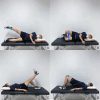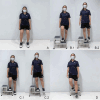Impact of telehealth-based therapeutic exercise on pain, functional performance and dynamic knee valgus in young adult females with patellofemoral pain: a randomised controlled trial
- PMID: 39720152
- PMCID: PMC11667270
- DOI: 10.1136/bmjsem-2024-001939
Impact of telehealth-based therapeutic exercise on pain, functional performance and dynamic knee valgus in young adult females with patellofemoral pain: a randomised controlled trial
Abstract
Objectives: This study aimed to evaluate the effectiveness of a telehealth-based therapeutic exercise (TTE) programme with real-time video conference supervision for young adult females with patellofemoral pain (PFP).
Methods: The study design was a randomised controlled trial. Forty-two participants with PFP were allocated to either the TTE group or the control (C) group. The TTE group received a 4-week telehealth-based exercise programme supervised through real-time video conferencing, while the C group followed a self-guided stretching exercise. Pain intensity was assessed using the Visual Analogue Scale, while functional performance was evaluated with hop tests and the step-down test. Dynamic knee valgus was measured by the frontal plane projection angle during a single-leg squat. In addition, the study used a specific health questionnaire which evaluated knee pain and function, including the self-administered Kujala Patellofemoral Questionnaire (KPQ). All outcomes were assessed both before and after the intervention.
Results: After the 4-week interventions, the results showed a significant interaction between the group and the time of pain intensity, functional performance and dynamic knee valgus (p<0.001). The TTE group demonstrated significant pain reduction (p<0.001) and improved KPQ score (p<0.001), while the C group showed no significant changes. TTE participants also exhibited improved functional performance in the hop and step-down tests. Additionally, dynamic knee valgus was significantly decreased in the TTE group.
Conclusion: The telehealth-based exercise programmes offer a convenient and effective alternative for managing PFP symptoms, providing remotely accessible and specialised care.
Keywords: Exercise rehabilitation; Knee; Patellofemoral Pain Syndrome; Performance.
Copyright © Author(s) (or their employer(s)) 2024. Re-use permitted under CC BY-NC. No commercial re-use. See rights and permissions. Published by BMJ Group.
Conflict of interest statement
None declared.
Figures




Similar articles
-
The Effect of Valgus Control Instruction Exercises on Pain, Strength, and Functionality in Active Females With Patellofemoral Pain Syndrome.Sports Health. 2019 May/Jun;11(3):223-237. doi: 10.1177/1941738119837622. Epub 2019 Apr 29. Sports Health. 2019. PMID: 31034336 Free PMC article. Clinical Trial.
-
CONSISTENCY OF DYNAMIC KNEE VALGUS KINEMATICS AND PAIN ACROSS FUNCTIONAL TASKS IN FEMALES WITH PATELLOFEMORAL PAIN: A CROSS-SECTIONAL STUDY.Int J Sports Phys Ther. 2020 Dec;15(6):985-994. doi: 10.26603/ijspt20200985. Int J Sports Phys Ther. 2020. PMID: 33344015 Free PMC article.
-
Two-dimensional frontal plane projection angle can identify subgroups of patellofemoral pain patients who demonstrate dynamic knee valgus.Clin Biomech (Bristol). 2018 Oct;58:44-48. doi: 10.1016/j.clinbiomech.2018.06.021. Epub 2018 Jul 3. Clin Biomech (Bristol). 2018. PMID: 30015205
-
Knee valgus angle during single leg squat and landing in patellofemoral pain patients and controls.Knee. 2014 Mar;21(2):514-7. doi: 10.1016/j.knee.2013.11.011. Epub 2013 Nov 27. Knee. 2014. PMID: 24380805
-
Patellofemoral pain in athletes.Open Access J Sports Med. 2017 Jun 12;8:143-154. doi: 10.2147/OAJSM.S133406. eCollection 2017. Open Access J Sports Med. 2017. PMID: 28652829 Free PMC article. Review.
Cited by
-
Effectiveness of Self-Training With a Web-Based Digital Health Application Versus Physiotherapy in the Treatment of Disorders of the Patella: Randomized Controlled Trial.J Med Internet Res. 2025 May 5;27:e66463. doi: 10.2196/66463. J Med Internet Res. 2025. PMID: 40323642 Free PMC article. Clinical Trial.
References
-
- Nilmart P, Yodchaisarn W, Vongsirinavarat M, et al. Patellofemoral Pain Syndrome in Young Adult Women With Low to Moderate Physical Activity Levels. IRJ . 2022;20:99–108. doi: 10.32598/irj.20.1.1565.1. - DOI
-
- Gaitonde DY, Ericksen A, Robbins RC. Patellofemoral Pain Syndrome. Am Fam Physician. 2019;99:88–94. - PubMed
LinkOut - more resources
Full Text Sources
